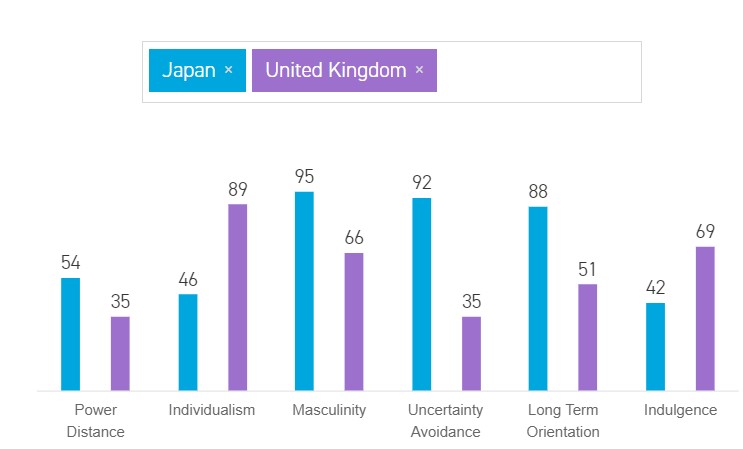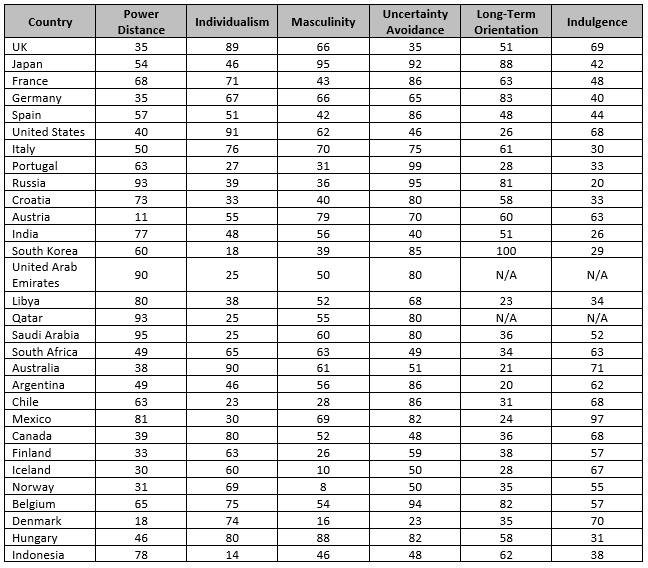An Introduction to Hofstede’s Cultural Dimensions Model
National culture has a strong effect on employee behaviours; for example, cultures emphasising individualism typically promote employee creativity and performance-based pay (Smith, 2004). However, there are few academic mechanisms for investigating this relationship. To address this, Geert Hofstede conducted a survey of 117,000 employees of IBM and created a unique model of six cultural dimensions, namely power distance, uncertainty avoidance, long-term orientation, individualism, masculinity, and indulgence. For individual countries, each of these dimensions is assigned a quantitative index ranging from 1 to 100. While the model was originally created by Hofstede to manage employee behaviours within IBM, the 6-D framework was of high relevance to other companies and fields of practise such as predicting the usage of renewable energy (Pelau and Pop, 2018). This article focuses on the key elements of the 6-D theory, how to use this model in academic works as well as the benefits and limitations of Hofstede’s cultural dimensions.
What Indicators Are Included in the Cultural Dimensions Model?
To understand how the 6-D model works, this section reviews each cultural dimension.
Power Distance
Power distance refers to the perceived acceptance of power inequality. A culture with a high power distance rating accepts that some stakeholders (e.g. managers) should be provided with more formal authority than others; the reverse is true for cultures with a low power distance score (HofstedeInsights, 2020a).
Individualism vs. Collectivism
This dimension reflects the conflict between one’s interests and the needs of large social groups. Collectivistic cultures expect strong employee loyalty to teams, departments and entire companies. Conversely, individualistic cultures allow employees to achieve individual success that is not immediately linked to collective goals. For example, 3M allows employees to dedicate 10% of their paid work time to personal projects (Govindarajan and Srinivas, 2013).
Masculinity vs. Femininity
The masculinity-femininity continuum reflects the need for personal achievement. Highly masculine cultures encourage assertiveness and meritocracy, favouring performance-based pay measures. On the other hand, feminine cultures argue for equality and cooperation. For the members of feminine societies, it is not necessary to display high performance to be valued.
Uncertainty Avoidance
Uncertainty avoidance indicates how a specific culture approaches managing risk. In cultures with a high uncertainty avoidance rating companies prefer to establish rigid employee codes of conduct and minimise deviations from desired employee behaviours (HofstedeInsights, 2020a). In contrast, low uncertainty avoidance allows for a greater degree of employee freedom and creativity.
Long-Term Orientation
This area focuses on whether a culture prefers following tradition instead of innovating. Cultures with a low long-term orientation score are conservative and avoid making creative decisions while the reverse is true for countries with a high long-term orientation index.
Indulgence vs. Restraint
Indulgence is defined as the degree to which a culture accepts satisfying individual needs and wants. This does not mean that company goals are sacrificed in favour of employee’s indulgences, however. Indulgent cultures typically provide their employees with more amenities, namely flexible working arrangements, or financial bonuses independent on individual performance.
How to Conduct a Hofstede’s Cultural Dimensions Analysis in Practice
If you want to use Hofstede’s cultural dimensions model in your report or essay, the following guidelines should be of help.
Attaining Data on Cultures
It is not needed to conduct additional surveys or read journal articles to conduct a good Hosftede’s 6-D analysis. The Hofstede Insights website provides a built-in tool for attaining the necessary data. While visiting this website (HofstedeInsights, 2020a), click on the ‘Our Models’ page and select the 6-D framework. From this page, click on the link to the country comparison tool. Choose one or more countries relevant to your work and you will automatically receive a graphical summary of how your chosen cultures rank according to Hofstede’s dimensions. The following is an example of a bar chart you should receive when using this instrument.
Figure 1: A Cross-Cultural Comparison of Japan and the UK
Source: HofstedeInsights (2020b, n.p.)
Structuring a Hofstede’s 6-D Analysis
The most frequent approach to structuring a Hofstede’s 6-D analysis is to discuss each dimension under a separate sub-heading. If you are faced with a strict word count limit, however, this approach is no longer applicable. Instead, you could summarise each dimension using a table (tables are typically excluded from the word count) or write three-four sentences on the most significant findings of Hofstede’s analysis. Do not forget to link these results to organisational behaviour such as leadership styles or employee reward schemes!
In the example above, Japan has a power distance rating of 54 while the corresponding index for the UK is 35. This means that Japanese companies prefer establishing hierarchical organisational structures while firms in the UK focus on implementing mechanisms of employee participation (e.g. joint employee meetings). Another key point of divergence is the uncertainty avoidance dimension (92 for Japan vs. 35 for the UK). An example illustrating this is Toyota using its Kaizen framework to standardise production and minimise uncertainty (Kurebwa and Mushiri, 2019). Companies in the UK, in contrast, do not feel the need to establish such strict codes of conduct (HofstedeInsights, 2020b).
Choosing when to Conduct a Hofstede Analysis
Typically, a Hofstede’s 6-D analysis is conducted when your assignment explicitly focuses on organisational culture and related issues, namely the choice of leadership styles, financial rewards and other measures of improving employee motivation, and increasing participation in employee voice initiatives (e.g. online surveys gathering employee feedback). Nonetheless, it is also possible to use Hofstede’s models to predict consumer behaviours (Pelau and Pop, 2018). In a hospitality setting, for example, Japanese tourists will exhibit high motivation to engage in guided tours consistent with Japan’s high uncertainty avoidance index (Huang and Crotts, 2019). You can also use Hofstede’s model in strategic reports asking you to design a global strategy for a particular enterprise. In this case, Hofstede’s 6-D framework could indicate whether a specific country would make a suitable market for international expansion. Continuing the above example, firms in the UK are not advised to expand to Japan by establishing a direct subsidiary owing to strong cultural differences between these two countries. Partnering with a local enterprise would be a less risky method of expansion.
Hofstede’s Ratings for 30 Popular Countries
If you do not have the opportunity to visit Hofstede’s website, the following table summarises Hofstede’s scores for 30 countries that are frequently encountered in academic assignments.
Table 1: Hofstede's Indices for 30 Popular Cultures
Source: HofstedeInsights (2020a, n.p.)
The above table shows that it is possible for a country to attain an index of 100 for a specific cultural dimension. The long-term orientation rating of South Korea is the maximum possible figure allowed in by the 6-D model. Another interesting finding is that some countries could exhibit low adherence to individual cultural norms as indicated by Indonesia’s low (14) score for individualism or Austria’s low (11) power distance index. If your assignment allows you to focus on one country of your choice, Indonesia, Austria or South Korea could provide valuable data for discussing organisational culture.
The Benefits and Limitations of Hofstede’s Model
The most significant benefit of Hofstede's 6-D model is its versatility. The framework can be applied to studies of organisational culture, national culture, consumer behaviour or organisational performance (Huang and Crotts, 2019). If you are required to critically evaluate the model, you should mention that Hofstede’s framework informs companies on how to implement different behaviour controls (e.g. codes of conduct for cultures focused on uncertainty avoidance) in different national subsidiaries. Nonetheless, Hofstede’s theory lacks justification for the chosen set of cultural dimensions. For example, while religion constitutes a vital component of national culture, this area is not explicitly included in the 6-D model (McSweeney, 2002). The theory also does not distinguish between national culture and individual culture. In other words, not all representatives of a specific national culture exhibit beliefs and behaviours arising from that culture’s cultural dimensions scores. The original survey conducted by Hofstede only focused on the employee of IBM and failed to include a representative sample of women or ethnical minorities. Because of this, Hofstede’s indices do not predict employee behaviours.
The Use of Hofstede’s Analysis in Our Services
Our professional essay and report writing services can conduct a full analysis of Hofstede’s dimensions for the countries of your choosing. If your requirements need you to use Hofstede’s framework, we will discuss Hofstede’s indices and what they mean for the organisations analysed in your coursework. When relevant, we will use figures and tables to highlight similarities and differences between various cultures. Critical analysis is essential to our services. Each Hofstede’s analysis will mention what your organisations of choice lack to address issues raised by Hofstede’s dimensions. We will also explicitly demonstrate what measures are adopted by relevant companies in response to national culture and how these instruments could be improved. For strategic reports, we will use Hofstede’s model to argue whether a company should expand to a particular country, what entry modes are the most beneficial for a firm or what challenges expect international firms based on the observed cultural dimensions. If required by your tutor, we will always mention the benefits and limitations of Hofstede’s model and how these limit the decision-making of specific businesses.
References
Govindarajan, V. and Srinivas, S. (2013) “The Innovation Mindset in Action: 3M Corporation”, [online] Available at: https://hbr.org/2013/08/the-innovation-mindset-in-acti-3 [Accessed on 15 May 2020].
HofstedeInsights (2020a) “The 6-D Model”, [online] Available at: https://hi.hofstede-insights.com/national-culture [Accessed on 15 May 2020].
HofstedeInsights (2020b) “Japan vs. the UK”, [online] Available at: https://www.hofstede-insights.com/country-comparison/japan,the-uk/ [Accessed on 15 May 2020].
Huang, S. and Crotts, J. (2019) “Relationships between Hofstede's cultural dimensions and tourist satisfaction: A cross-country cross-sample examination”, Tourism Management, 72 (1), pp. 232-241.
Kurebwa, J. and Mushiri, T. (2019) “Design and Simulation of an Integrated Steering System for All-purpose Sport Utility Vehicles (SUVs)–Case for Toyota”, Procedia Manufacturing, 35 (1), pp. 56-74.
McSweeney, B. (2002) “Hofstede's model of national cultural differences and their consequences: a triumph of faith – a failure of analysis”, Human Relations, 55 (1), pp. 89–117.
Pelau, C. and Pop, N. (2018) “Implications for the energy policy derived from the relation between the cultural dimensions of Hofstede's model and the consumption of renewable energies”, Energy Policy, 118 (1), pp. 160-168.
Smith, P. (2004) “Nations, Cultures and Individuals: New Perspectives on Old Dilemmas”, Journal of Cross-Cultural Psychology, 35 (1), pp. 6–12.



